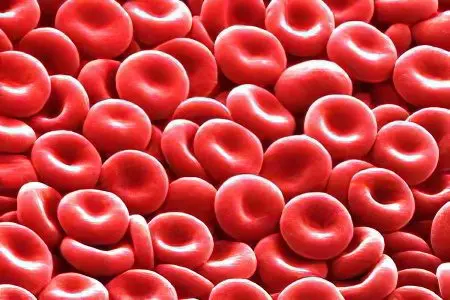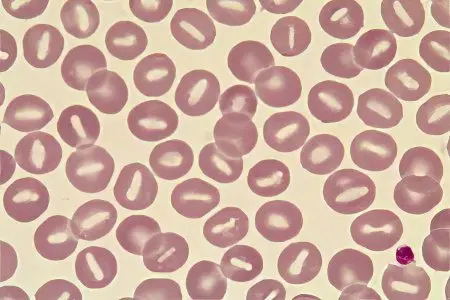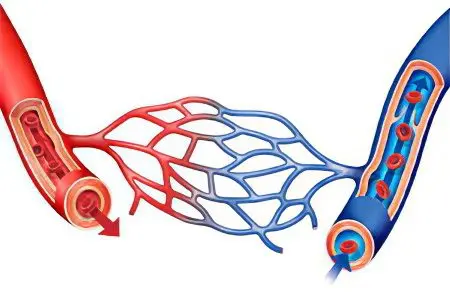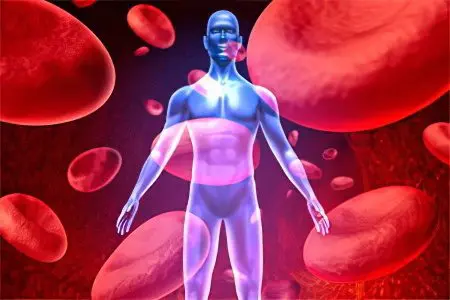Contents

Hypervolemia is an increase in the volume of blood available in the vascular system. Depending on the hematocrit index, simple, oligocythemic, polycythemic hypervolemia are distinguished. When diagnosing isolated hypervolemia of the pulmonary circulation, we are talking about pulmonary hypertension.
A disease is considered to be an excess of the normal volume of blood circulating in the human vascular system.
Causes and types of hypervolemia

Hypervolemia is not an independent disease, but a symptom complex of various pathologies.
There are the following blood components:
liquid part, or plasma;
shaped elements, or all blood cells.
Hematocrit is the ratio of the amount of blood cells to the total volume of blood in the vascular system. Its norm is from 36 to 48%, that is, in 100 ml of blood there are 36-48 ml of blood cells, the remaining 52-64 ml are plasma. The classification of the disease depends on the hematocrit index.
Simple hypervolemia

With this type of pathology, the hematocrit remains within the normal range, but the volume of blood circulating in the vascular system increases.
The reasons:
Transfusion of an amount of blood for which the volume of vessels is not designed;
High physical activity;
Significant increase in ambient temperature;
Hypoxia.
In all cases, except for the first, blood replenishes the circulatory system, coming there from its own depots.
Oligocytemic hypervolemia

The hematocrit index falls below the normative values, the blood volume increases due to the increase in plasma volume, and hydremia is formed.
Factors leading to hydremia:
pregnancy – changes in the composition of the blood contribute to the successful flow of metabolic processes between the fetus and the body of a pregnant woman;
intensive transport of fluid into the vascular system: transfusion of plasma and substitutes, soaking of the liquid component from the surrounding tissues in case of edema through the walls of blood vessels, drinking plenty of water;
violation of the process of dehydration: sodium retention, renal failure, increased secretion of antidiuretic hormone.
Polycythemic hypervolemia
With this type of hypervolemia, the hematocrit index increases due to an increase in the proportion of the cellular component in the vascular system.
Causes:
hematological pathologies: tumors of any etiology, genetically determined developmental anomalies;
hypoxia caused by a long stay in the highlands, heart and lung failure.
Symptoms, diagnosis and treatment of hypervolemia

Its symptoms and the prescribed treatment tactics depend on the type of pathology. If the disease is caused by causes to which the body can adapt, and its symptoms are short-lived, the circulatory system will recover on its own.
If the disease is based on an acute or chronic dysfunction of organs and systems, therapy is aimed at reducing the volume of circulating blood, at correcting the symptoms of the disease.
Symptoms:
Increased blood pressure;
Manifestations of angina pectoris, heart failure;
Dyspnea;
swelling;
Feeling of heaviness when breathing, increasing its frequency;
Lower back pain;
Headache;
Increase in body weight;
urination disorders;
Dry skin and mucous membranes;
Increased fatigue.
Modern medicine does not have in its arsenal methods for determining the volume of circulating blood. The diagnostic methods available today are applicable only in experimental medicine and have no practical value. To determine the type of pathology and its causes in hematology, the determination of the hematocrit index is used.
Therapy of the disease is carried out in two directions:
Etiotropic treatment – eliminates the cause of hypervolemia;
Symptomatic treatment – stops the manifestations of pathology.
What is etiotropic treatment aimed at:
Surgical treatment of heart defects;
Therapy of diseases of the endocrine, urinary system;
Genetically determined diseases of the circulatory system;
Tumors of any etiology;
Infusion volume control for intravenous infusions.
Directions for symptomatic treatment:
Relief of high blood pressure with antihypertensive drugs in combination with diuretics;
Reducing the load on the heart against the background of the use of drugs for the treatment of angina;
Placing the patient in an environment with a comfortable temperature, saturated with oxygen.
Recipes of traditional medicine:
Hirudotherapy (treatment with leeches): reduces the volume of blood, dilutes it and slightly reduces the number of formed elements;
Diuretics of plant origin: fennel, horsetail, bearberry, dill, viburnum.
It is important that diagnostic and therapeutic measures are carried out under the guidance of an experienced physician, because a seemingly harmless condition can mask the initial stages of a complex pathology.
Hypervolemia of the pulmonary circulation

The human circulatory system consists of large and small circles of blood circulation. The large circle includes vessels that feed all organs and tissues except for the vessels that feed the broncho-pulmonary system, the small circle includes only the vessels of the lungs.
Distribution of blood in the circulatory system:
in veins – 70%;
in the arteries – 15%;
in capillaries – 12%;
inside the heart muscle – 3%.
Hypervolemia of the pulmonary circulation is based on high pressure in the vessels of the broncho-pulmonary system, therefore it is called pulmonary hypertension.
Causes of hypervolemia of the small circle

Factors leading to pulmonary hypertension:
Reflex constriction of the small vessels of the lungs. Occurs with severe stress, mitral valve stenosis, embolism.
Prolonged alveolar hypoxia. Occurs as a result of silicosis, chronic bronchitis, emphysema, obstructive pulmonary disease, anthracnose, bronchiolitis, bronchiectasis.
Left ventricular failure. Occurs with cardiac arrhythmia, as a result of a heart attack, myocarditis.
Increased blood density.
Increased pressure within the airways. Occurs with a strong cough, an increase in the barometric pressure of the external environment, violations of the ventilator.
Narrowing of the blood vessels that carry blood out of the lungs. Occurs with aortic aneurysm, tumors, adhesions, congenital malformation.
Genetically determined pathology of the enzyme system.
Increased output of blood from the right ventricle.
Narcotic intoxication with psychostimulants.
AIDS virus infection.
portal hypertension. Causes: cirrhosis of the liver, Budd-Chiari syndrome.
Apnea, or stopping breathing during a night’s sleep due to snoring.
In addition to the above factors, there are also idiopathic (unknown) causes leading to primary pulmonary hypertension.
Signs of pulmonary hypervolemia

The primary stage of the disease may go unnoticed by the patient. When the symptoms of the disease clearly indicate the presence of dangerous changes, most often the process has gone far, and it is already irreversible.
Signs of pathology:
shortness of breath, turning into suffocation with increasing load;
asthenia, its symptoms: insomnia, weight loss, decreased performance, mental instability;
fainting under load;
dizziness;
severe cough without sputum, in advanced cases with hemoptysis;
heartache;
progressive cyanosis;
arrhythmia;
hurts in projections baked.
Diagnosis of hypervolemia of the small circle

Diagnosis of the disease is based on its clinical picture, data from laboratory and instrumental studies:
Electrocardiogram (ECG) – helps to identify right ventricular hypertrophy, heart attack, heart rhythm disturbances, pulmonary embolism;
Chest x-ray – helps in the last stages of the disease to identify increased vascular pattern, hypertrophy of the heart muscle;
Computed tomography with contrast is an extremely informative study of the state of the heart and blood vessels;
Ultrasound of the heart – helps to diagnose congenital anomalies, hypertrophy of the heart muscle, to clarify the indicators of vascular blood flow;
Catheterization of the pulmonary trunk in combination with the introduction of a sensor inside it – allows you to measure the pressure in the vascular system of the small circle, diagnose or exclude pathology.
Treatment of pulmonary hypervolemia
The main direction of pathology therapy is the elimination of the cause that caused it, since hypervolemia is not an independent disease. Pulmonary hypervolemia is provoked by pathological processes occurring in various systems of the human body. The most difficult to treat primary hypertension, since its cause is not established, the source of negative symptoms is unknown.
In the treatment of pulmonary hypervolemia, drugs and methods used in standard treatment regimens for arterial hypertension are used. With a decrease in the effectiveness of antihypertensive treatment, Eufillin and oxygen therapy are used.









